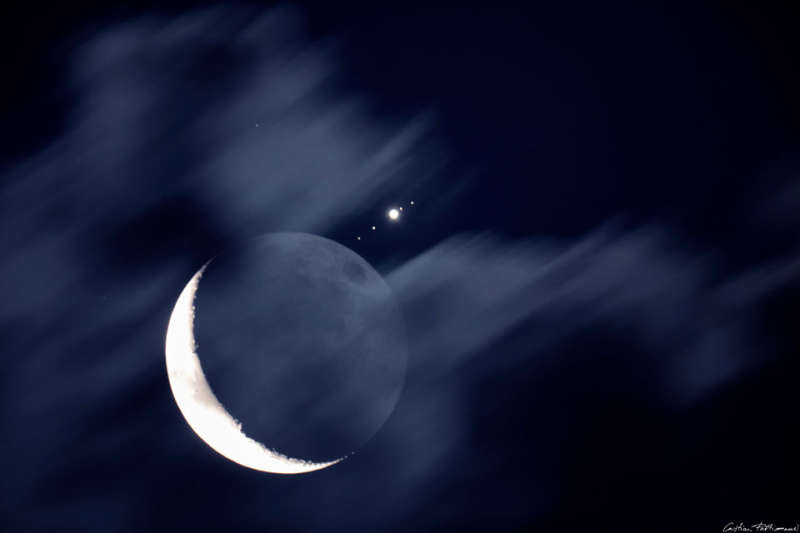Credit & Copyright: Cristian Fattinnanzi
Explanation:
What's that next to the Moon?
Jupiter -- and its four largest moons.
Skygazers
around planet Earth enjoyed the close encounter of planets and
Moon in 2012 July 15's predawn skies.
And while many saw bright Jupiter next to the slender, waning crescent,
Europeans also had the opportunity to watch the
ruling gas giant pass
behind the lunar disk, occulted by the Moon as it slid through the
night.
Clouds threaten in this telescopic view from
Montecassiano,
Italy, but
the frame still captures Jupiter after it emerged from the occultation
along with all four of its large Galilean moons.
The sunlit crescent is overexposed with the Moon's night side faintly
illuminated by Earthshine.
Lined up left to right beyond the dark lunar limb are Callisto,
Ganymede, Jupiter, Io, and Europa.
In fact,
Callisto, Ganymede, and Io are larger than Earth's Moon, while
Europa is only slightly smaller.
Last week,
NASA's Juno became the second
spacecraft ever to orbit Jupiter.
Transparent Science:
Browse 1,250+ codes in the Astrophysics Source Code Library
1999 2000 2001 2002 2003 2004 2005 2006 2007 2008 2009 2010 2011 2012 2013 2014 2015 2016 2017 2018 2019 2020 2021 2022 2023 2024 2025 |
Yanvar' Fevral' Mart Aprel' Mai Iyun' Iyul' Avgust Sentyabr' Oktyabr' Noyabr' Dekabr' |
NASA Web Site Statements, Warnings, and Disclaimers
NASA Official: Jay Norris. Specific rights apply.
A service of: LHEA at NASA / GSFC
& Michigan Tech. U.
|
Publikacii s klyuchevymi slovami:
Moon - occultation - Luna - Yupiter - galileevy sputniki
Publikacii so slovami: Moon - occultation - Luna - Yupiter - galileevy sputniki | |
Sm. takzhe:
Vse publikacii na tu zhe temu >> | |
